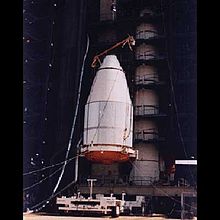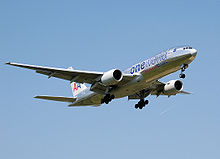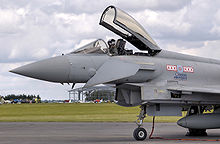- Nose cone
-
For the Transformers character, see Nosecone (Transformers).
 A nose cone that contained one of the Voyager spacecraft, mounted on top of a Titan III/Centaur launch vehicle.
A nose cone that contained one of the Voyager spacecraft, mounted on top of a Titan III/Centaur launch vehicle.
 Boeing 777-200ER of American Airlines. The nose cone is the most forward fuselage piece (painted white here).
Boeing 777-200ER of American Airlines. The nose cone is the most forward fuselage piece (painted white here).
The term nose cone is used to refer to the forwardmost section of a rocket, guided missile or aircraft. The cone is shaped to offer minimum aerodynamic resistance. Nose cones are also designed for travel in and under water and in high speed land vehicles.
Contents
Rocket
On a rocket vehicle it consists of a chamber or chambers in which a satellite, instruments, animals, plants, or auxiliary equipment may be carried, and an outer surface built to withstand high temperatures generated by aerodynamic heating. Much of the fundamental research related to hypersonic flight was done towards creating viable nose cone designs for the atmospheric reentry of spacecraft and ICBM reentry vehicles.
In a satellite vehicle, the nose cone may become the satellite itself after separating from the final stage of the rocket or it may be used to shield the satellite until orbital speed is accomplished, then separating from the satellite.
Aircraft
On airliners the nose cone is also a radome protecting the weather radar from aerodynamic forces.
The shape of the nose cone must be chosen for minimum drag so a solid of revolution is used that gives least resistance to motion. The article on nose cone design contains possible shapes and formulas.
Hypersonic
Due to the extreme temperatures involved, nose cones for high-speed applications (eg. hypersonic speeds or atmospheric reentry of orbital vehicles) have to be made of refractory materials. Pyrolytic carbon is one choice, reinforced carbon-carbon composite or HRSI ceramics are other popular choices. Other design strategy is using ablative heat shields, which get consumed during operation, disposing of excess heat that way. Materials used for ablative shields include, for example carbon phenolic, polydimethylsiloxane composite with silica filler and carbon fibers, or as in of some Chinese FSW reentry vehicles, oak wood.[1]
In general, the constraints and goals for atmospheric reentry conflict with those for other high speed flight applications; during reentry a high drag blunt reentry shape is frequently used, which minimises the heat transfer by creating a shock wave that stands off from the vehicle, but some very high temperature materials may permit sharper edged designs.
Nose cone design
Main article: Nose cone designGiven the problem of the aerodynamic design of the nose cone section of any vehicle or body meant to travel through a compressible fluid medium (such as a rocket or aircraft, missile or bullet), an important problem is the determination of the nose cone geometrical shape for optimum performance. For many applications, such a task requires the definition of a solid of revolution shape that experiences minimal resistance to rapid motion through such a fluid medium, which consists of elastic particles.
See also
References
- ^ "Ballistic Missile Basics". Special Weapons Primer. Federation of American Scientists. http://www.fas.org/nuke/intro/missile/basics.htm. Retrieved 2008-02-03.
Categories:- Rocketry
Wikimedia Foundation. 2010.

